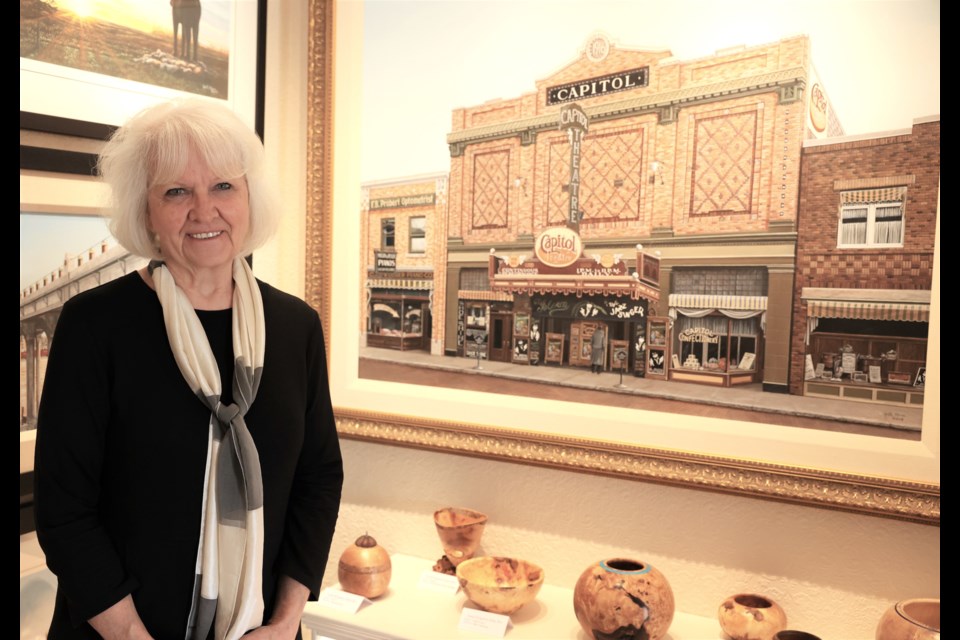From wide-open skies to grain elevators to historic structures, Yvette Moore has always focused her paintings on the Prairies and heritage buildings because she believes they define life in Saskatchewan.
Moore — who operates the Yvette Moore Gallery at 76 Fairford Street West — has been painting for over 50 years and still has the first painting she created at age 14. She originally started painting with oils but eventually discovered acrylics and stuck with them since they were easier to use.
During those five decades, the Radville-born painter has consistently focused on the province’s landscape and its nostalgic effect on people.
“I love the architecture of our historical buildings, and I’ve done quite a few pieces (and) I’ve focused on that,” she said. “Something that even brings back something that doesn’t exist anymore (such as the old Capitol Theatre and Temple Gardens Dance Hall) and is able to revive a memory for many people.”
The Prairies and heritage structures are “who we are” and have shaped Saskatchewan’s story, she continued. She could paint mountains, but that isn’t who she is or what people see living here.
“I think that’s one of the things from all our customers is that, when they look at our paintings, they either see themselves in it or … they want to take something of the Prairies home with them,” Moore remarked.
“You can be surrounded by what’s around you all the time, but for some reason, when it’s been put on a different medium … people see it differently and they have a much better appreciation.
“One of my favourite things is painting skies — more than anything — because that is very much part of our Prairies,” she laughed.
One of Moore’s favourite paintings she created is called “Eva’s popcorn stand.” The artwork features four of her children and is based on her hometown of Radville.
“It’s a memory that people still enjoy there to this day,” she added.
From the beginning
Moore has participated in the Moostletoe Tour “since day 1.” She does so because not only is she an artist, but her business represents many artisans who don’t have the opportunity to display their work, don’t have a public place to showcase it, and are not always local.
“So, I think this way it gives everyone a chance to showcase their work in (this) environment,” Moore said. “And especially because we get to show it in this amazing building too, so it’s kind of a win-win when we’re partnering the heritage building with the art within it. It works really well.”
Moore hopes that when people visit the gallery, they will see art that educates them and makes them appreciate it. Some people will purchase art that day, and for those who don’t, they know the gallery has something interesting they can buy later as a gift.
Besides Moore’s work, another artist the gallery will highlight is former Moose Javian Rob Froese, an esteemed potter and the son of the late Gus Froese. This respected artist painted dozens of murals throughout the community.
Helping others
The Yvette Moore Gallery features the works of 40 to 50 smaller artists from across Western Canada, although 90 per cent are from Saskatchewan.
Moore explained that her gallery includes so many others because she knows first-hand how difficult it is to make a living as an artist and be visible. She began her career working out of her home, which eventually turned into a family-run business that included her children.
“It grew into more than just me. So it was, ‘How do I make it so it’s financially viable for all of us?’” she said.
Moore has seen many artworks during her travels in Western Canada and realized Saskatchewan is fortunate to have talented and high-calibre artists. This was particularly apparent when she visited British Columbia with her daughters and visited galleries there.
“We came home with a much better appreciation for those that we have here. We’re as good as any of them, if not — in some cases — better,” she said.
A career boost
Nearly 30 years ago, Moore teamed up with Weyburn writer Jo Bannatyne-Cugnet to create the book “A Prairie Alphabet,” which boosted Moore’s work nationally and internationally. People could now enjoy her work anywhere while looking through a book.
“It was absolutely one of the best things that (ever happened to me). It made a huge change in how I was viewed as an artist,” she said, adding another re-print of the 1994 book is coming.
A community leader
Moore could be seen as a leader in the art community, considering her career has spanned half a century. She answers many questions from younger artists about how to pursue a career in this field. She is honest and says being a full-time artist is not easy; hard work is a must; and success doesn’t fall into one’s lap.
She also encourages teenagers to attain every non-art-related school subject to be well-rounded.
“Being an artist is like running a business. So you still need all those other skills. And the more you know, the more you can add to your art (and) the more you understand your art,” she added. “Everything that happens to you, (it) all becomes part of your creations.”




